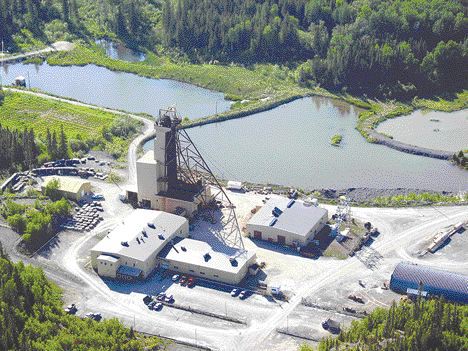Reinterpreting mineralized structures has paid off for Red Lake and other old gold mining camps in Ontario. Could Kirkland Lake be next?
The two intersections, with an average true width of about 30 ft., are thought to be among the best on record for the Kirkland Lake camp. KGI jumped to $4.30 on the results, but has since settled at about $4.00 in a 52-week range of $3.40-$7.04.
More recently,
These discoveries come a decade after
Kirkland Lake Gold is in the second year of a 3-year, $21-million exploration program designed to add 15 million tons to current reserves. The program has so far intersected nine mineralized structures, including at least five north-south trending high-grade gold zones, south of the Macassa mine. Proven and probable reserves have grown to 2.02 million tons grading 0.46 oz. per ton (927,000 contained ounces) and resources to 1.95 million tons grading 0.37 oz. per ton (720,000 contained ounces).
The new gold-bearing structures are unusual in two respects. First, some occur in sulphide zones, a style of mineralization atypical of the Kirkland Lake camp, where quartz veins have traditionally held most of the gold value. Second, their orientation goes against the grain of productive zones in the camp, most of which trend east-west.
“North-trending gold-bearing zones were previously unknown to occur in the Kirkland Lake camp and (their) discovery adds a new dimension to gold potential in the area,” says the 2004 regional report prepared by Gerhard Meyer, the resident geologist at the Ontario government’s Kirkland Lake Resident Geologist’s Office.
Meyer is also intrigued by the possibility that some of these north-trending structures, which may never have been explored because they are barren at surface, pick up grade at depth.
Macassa’s geology consists of Timiskaming tuffs, conglomerates and syenite porphyries. Traditional gold mineralization is preferentially hosted in the syenites and occurs along breaks and subordinate splays in quartz-filled fractures.
To better define the new zones with underground drilling, Kirkland Lake Gold plans to run a 2,500-ft. drift south from the mine workings. At a depth of 5,340 ft., the drift will intersect several of the mineralized structures, including the high-grade zone drilled during the summer. The end of the drift will give the junior access to the Kirkland Lake Main Break at the 7,000-ft. level.
Other juniors have been quick to capitalize on the winning trio of exploration success, gold prices of more than US$450 per oz. and availability of capital for the region. By focusing on established gold camps with good infrastructure, this new wave of explorers may be able to avoid the pitfalls of the flow-through years of the 1980s, when the US$3 billion spent on gold exploration in Canada yielded few new mines.
Queenston, a fixture in the Kirkland Lake camp with land holdings covering a 27-km continuous length of the gold-bearing Larder Lake break, has launched a $3-million exploration program this year to investigate gold mineralization both at depth and near surface. It’s the company’s biggest program in the camp since 1997.
This fall, Queenston will follow-up recent exploration success with a third phase of drilling to test the newly discovered zone below the mine workings and expand the Contact and Central zones at Upper Beaver. The program will consist of 12 holes and 7,000 metres of drilling.
Queenston’s 138-sq.-km land package encompasses four former producers with historical gold production totalling 3.4 million oz. The properties contain measured and indicated resources of 4 million tons grading 0.18 oz. per ton (700,000 oz.) and inferred mineral resources of 5.3 million tons grading 0.16 oz. per ton (850,000 contained ounces).
Placer Dome
Adjacent to one of Queenston’s properties in Lebel Twp.,
Under the option terms, Placer Dome will acquire a 60% interest in the Lebel property by spending $2 million on exploration over four years and making option payments of $180,000. The major can earn an additional 10% interest by committing to a feasibility study.
“It’s encouraging to see a major back in the camp,” says Queenston President Charlie Page.
While Placer explores Lebel, Vault is busy compiling results from a drill campaign at the adjacent Lake Shore mine, which penetrated Vault’s Kirkland Lake property between 1932 and 1962. The compilation will lead to an interpretation of potential gold-bearing structures parallel and sub-parallel to the Kirkland Lake main break.
Next door to Lebel, in Teck Twp.,
Farther east in McVittie Twp.,
The market is also watching the impending merger between
— The author is a freelance writer based in Toronto.


Be the first to comment on "Kirkland Lake: the next Red Lake?"